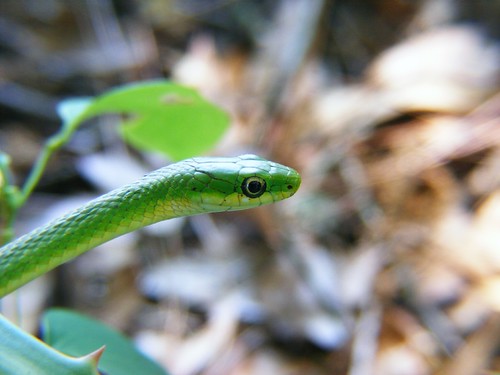The Rough Green Snake (Opheodrys aestivus) is a non-venomous North American snake. It is sometimes Grass Snake or Green Grass Snake, but these names are more commonly applied to the Smooth Green Snake, Opheodrys vernalis. (The European colubrid called Grass Snake is unrelated.) The Rough Green Snake is docile, often allowing close approach by humans, and seldomly bites.
The snake is bright green above and has a yellowish belly, affording it excellent camouflage in green vegetation. It grows up to 46 inches in length and is very thin. The Rough Green Snake ranges throughout the Southeastern United States, from Kansas and Texas east to New Jersey and south to Florida. It is absent from the higher elevations of the Appalachian Mountains.
It is also found in northeastern Mexico, including the state of Tamaulipas and eastern Nuevo León. Its preferred habitat is moist meadows and woodlands, often near water. It is highly arboreal, frequently found climbing in low vegetation, and is also a good swimmer. However it is often found on the ground as well. Unlike many snakes, it is largely diurnal. Its diet consists mostly of insects and other terrestrial arthropods, but some snails and tree frogs are eaten as well. This snake is not a constrictor--most prey are grabbed and simply swallowed alive.
The snake is bright green above and has a yellowish belly, affording it excellent camouflage in green vegetation. It grows up to 46 inches in length and is very thin. The Rough Green Snake ranges throughout the Southeastern United States, from Kansas and Texas east to New Jersey and south to Florida. It is absent from the higher elevations of the Appalachian Mountains.
It is also found in northeastern Mexico, including the state of Tamaulipas and eastern Nuevo León. Its preferred habitat is moist meadows and woodlands, often near water. It is highly arboreal, frequently found climbing in low vegetation, and is also a good swimmer. However it is often found on the ground as well. Unlike many snakes, it is largely diurnal. Its diet consists mostly of insects and other terrestrial arthropods, but some snails and tree frogs are eaten as well. This snake is not a constrictor--most prey are grabbed and simply swallowed alive.
Predators of the Rough Green Snake include birds, spiders, and other snakes, such as the Eastern Racer, Coluber constrictor and the Eastern King snake, Lampropeltis getula.
The Rough Green Snake breeds in spring, and sometimes again in fall. Females lay 2-14 eggs, occasionally in a communal nest shared by more than one female. Up to 75 eggs have been found in one such nest. The nest site varies: under boards, under bark in rotting stumps, in deep mulch, or under a rock. Hatchlings from spring breeding typically emerge in August or September, and are about 7-8 inches in length.
The Rough Green Snake is widespread and is not of conservation concern, in general. However urban development, especially the reduction of vegetation near waterways, may reduce their numbers. Many are killed on roads, and they may be susceptible to poisoning by pesticides used on their insect prey.
The Rough Green Snake breeds in spring, and sometimes again in fall. Females lay 2-14 eggs, occasionally in a communal nest shared by more than one female. Up to 75 eggs have been found in one such nest. The nest site varies: under boards, under bark in rotting stumps, in deep mulch, or under a rock. Hatchlings from spring breeding typically emerge in August or September, and are about 7-8 inches in length.
The Rough Green Snake is widespread and is not of conservation concern, in general. However urban development, especially the reduction of vegetation near waterways, may reduce their numbers. Many are killed on roads, and they may be susceptible to poisoning by pesticides used on their insect prey.



No comments:
Post a Comment